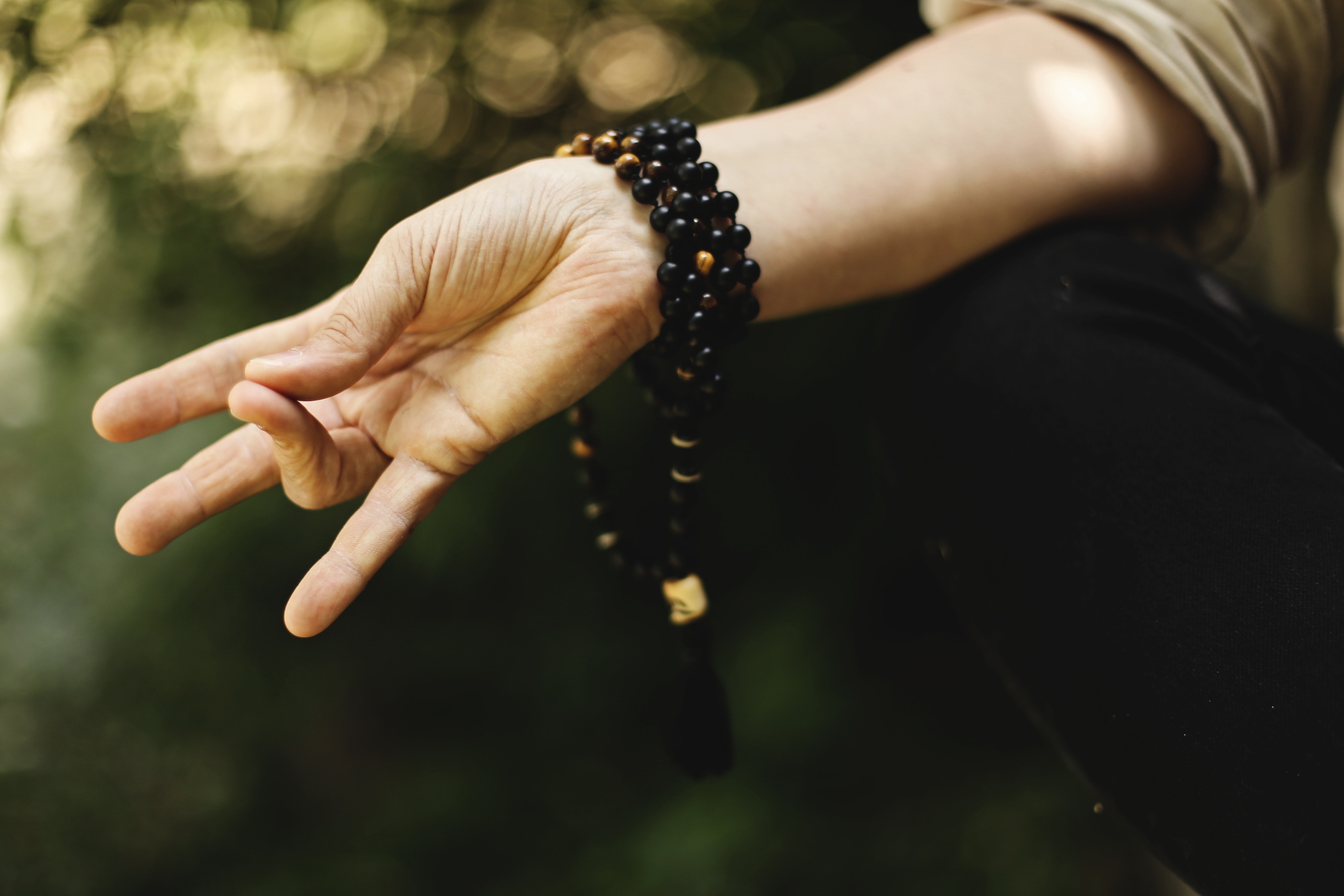
HOW TO COMMIT TO MEDITATION
Unless you have been living under a rock, we all know that meditation is one of the best things we can do to vastly improve our overall wellness. Meditation is not a one and done, wham-bam-thank-you-ma’am type of activity. In order for us to truly embody its benefits, it MUST be “practiced” – done consistently and daily over a long period of time. For the unalloyed discipline that it demands requires something we all run from COMMITMENT. Frightening, isn’t it?
Looks Easy Enough? Think Again.
From the outside, one may appear to be just sitting silently, however, meditation can also be frustratingly painful in all aspects of our human experience. Speaking as a meditation teacher and practitioner, I have met countless aspiring meditators who feel they are unable to cultivate the discipline inherent to the practice. From physical discomfort, the overwhelming chatter of our thoughts, to justifying the time and effort, it is all too easy to become discouraged or clever in our excuses when actually committing to meditate.
Physical Challenges to Meditation
Excuse: Sitting on the floor is uncomfortable for me. due to muscle tightness
Solution: Elevate your seat!
Knee injuries, tight muscles in the hips and legs tend to be a barrier to entry for many. We can combat the discomfort of the cross-legged seated meditation position by making a stack of pillows on the floor and situating your bum right on top of them. Sitting with your pelvis slightly elevated above your knees will also keep blood circulation unobstructed from the hips to your feet, preventing your legs from cramping or falling asleep. You could also decide to invest in a meditation floor cushion which can be found on Amazon for $12 and up.
Obstacle: I can’t sit up straight
Solution: Sit against a wall (or in a chair with firm back support).
It incumbent that one meditates with a straight spine because breathing is a critical point of focus for all if not most forms of seated meditation. When you sit with a slouched posture, you collapse weight on your rib cage and internal organs. This reduces your lungs’ capacity, causing your breath to become shallow, and thus less oxygen is able to enter your bloodstream. The better, and more fully you are able to breathe, the more refreshed you will feel. That is the magic of the brain receives oxygenated blood.
Obstacle: I am always fidgeting
Solution: Use Your Hands!
Often Coupled with the ritual of seated meditation is the practice of Mudra. Mudra, meaning “seal” in Sanskrit, are a series of specific hand gestures one holds while sitting in meditation. The most common one we tend to see is the Anjali Mudra or prayer hands, symbolic of offering gratitude. Not only do these sacred hand gestures help to cultivate an intention for the practice, they are a physical stimulus for the mind and the nervous system to help anchor your concentration. Namaste, Y’all.
Our Greatest Adversary- The Mind
The Vedic literature speaks at length on the power of our minds, poetically cautioning that our mind can be our best friend or our worst enemy. Meditation is not easy for ANYONE, no matter who you are. The gurus of the ancient past acknowledged this, noting that in the practice of meditation, we are meant to experience suffering to some degree. In order to clear the mind, we must go through the mind, clearing out our distortions born of limited perception and wrong view. To clean a mess, we have to sort through the garbage. Though unpleasant, it is necessary, and let’s be honest, we ALL have garbage (If anyone says they otherwise, they are flat out lying out as their garbage pile towers even higher).
Your Mind Says: I don’t have time.
My Rebuttal: YES YOU DO.
If you have time to take a sh*t, then you have time to meditate. You do not have to sit as long as the Zen monks. My recommendation: sit for 2 minutes for the first few days or week. Then each proceeding week after, gradually increase your meditation time by one minute. Start simple and start small, in this way you will not become overwhelmed and throw in the towel altogether. You never want to force yourself into sitting for a length of time you are not ready for. Nobody likes a forced commitment and this also goes for meditation.
Your Mind Says: I have too much on my mind
My Rebuttal: WE ALL DO.
The purpose of meditation is to NOT stop thinking, that is impossible for all conscious beings. Meditation “calms” the mind not through the absence of thoughts, but changing our relationship to our thoughts. As you sit and meditate thoughts will arise. What we practice is not entertaining or reacting to our thoughts, consciously choosing to distance our awareness from the emotion attached to the thought. In meditation, it is as if you are a biologist observing a family of monkeys in a zoo: you are present within the situation within time and aware of all of their monkey movements, yet you are NOT in the cage with the monkeys nor are you interacting with them. You are a 3rd party who is not emotionally invested in the monkey’s activities. You are simply just witnessing the pastimes of primates.
If easily distracted by the sound of traffic or incessant noise from construction, grab your earbuds and listen to a few ambient tracks on Spotify.
Your Mind Says: I’m so flakey, I’ll just forget.
My Rebuttal: SAME TIME, SAME PLACE
The most optimal time to meditate is actually in the morning after you first wake up. The morning is when your mind is most clear because the on-goings of your day have not made their impressions on it yet.
However, there is never a bad time to meditate. To establish a meditation habit, it needs to be linked to an activity that you already do in a particular place every day. Example: after you brush your teeth in the morning in your apartment or before afternoon meetings in Midtown. Choose a time and set reminders. Program your phone to give you 3 notifications: one for 2 hours before your designated meditation time, one for an hour before, and one for your actual meditation session. This will help to encode memory patterns in your brain that will integrate meditation in as part of your day’s routine.
Additionally, choose a space that you associate with your meditation time. It can be anything from carving out a 2ft clear corner in your apartment or your office building’s stairway. Time creates memory and space holds energy.
Your Mind Says: I don’t know how / I don’t know the right way
My Rebuttal: GET YOUR ASS TO CLASS
Spare yourself from the YouTube videos and free up some space in your phone by deleting that meditation app. Although it does appear that sitting to meditate is a completely solitary act, the ancient meditation traditions make it quite clear that anyone seeking to start a practice must find a bona fide teacher. Learning to practice properly early in your meditation endeavors is instrumental in clearing the initial mental roadblocks and queries you may have. Because they can observe your practice in person, you benefit from receiving personalized instructions suited to your needs.
In recent years, our city has given rise to a few spaces just dedicated to teaching meditation Additionally, not all but a good number of Yoga studios offer 30-minute meditation classes a few days a week on their schedules. Pre-registration is not required and will usually cost around $10. In these group settings, you are not sitting in complete silence because the teacher leads the class with a guided breath-awareness meditation, offers techniques to help you sit comfortably, and to bring your awareness back to the present when your thoughts start to wander and race. In these supportive spaces, you are free to ask questions and share your experiences with fellow meditators also seeking to calm their headspace.
http://credit-n.ru/zaymyi-next.html
http://credit-n.ru/zaymyi-next.html
http://credit-n.ru/zaymyi-next.html
http://credit-n.ru/zaymyi-next.html





